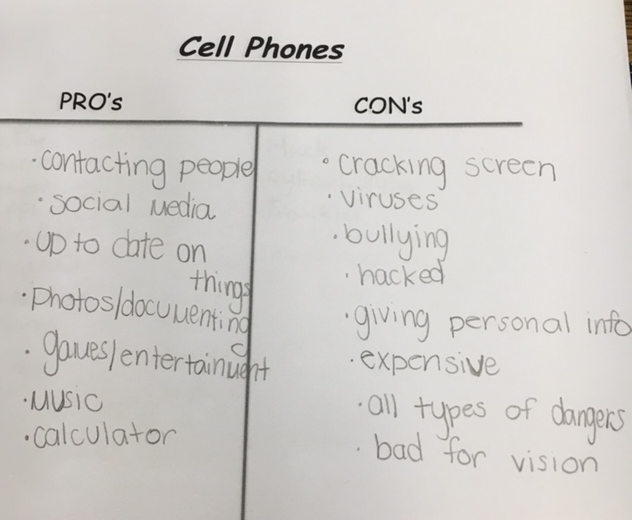- Author:
- Melody Casey
- Subject:
- English Language Arts
- Material Type:
- Lesson Plan
- Level:
- Upper Primary
- Grade:
- 5
- Tags:
- License:
- Creative Commons Attribution Non-Commercial
- Language:
- English
Education Standards
GEDB Social Issues Within Our Worlds: Text Messaging During Nigerian Riots (Lesson 2 of 4)

Overview
During this lesson, students will discover how social media plays a vital part in today's society. This lesson focuses mainly on the usage of cell phones and text messaging used during the Nigerian Riots. Students will discuss how social media has changed over the years, the pros and cons of cell phones, researching the Nigerian Riots, determining how text messages influenced the Nigerian Riots, and will conclude with writing/blogging about how cell phone text messaging influences issues that occur in our everyday lives. This lesson was developed by Christina Hartzell as part of their completion of the North Carolina Global Educator Digital Badge program. This lesson plan has been vetted at the local and state level for standards alignment, Global Education focus, and content accuracy.
Lesson Plan
Description
During this lesson, students will discover how social media plays a vital part in today's society. This lesson focuses mainly on the usage of cell phones and text messaging used during the Nigerian Riots. Students will discuss how social media has changed over the years, the pros and cons of cell phones, researching the Nigerian Riots, determining how text messages influenced the Nigerian Riots, and will conclude with writing/blogging about how cell phone text messaging influences issues that occur in our everyday lives.
Content
Student Engagement/Motivation
Students will start this lesson by completing a T-Chart (Pros vs. Cons) about cell phones. Students will independently list all of the pros and cons of cell phone usage they can recall. They will then gather in groups of 3-4 to share out their answers in order to add ideas to their own charts. Finally, as a whole class, they will create an anchor chart (Use chart paper to make a larger version of the T-chart. This will be posted in the classroom where the students can refer back to it as needed.) that lists all of the pros vs. cons the students brainstormed. As the lesson continues, you can add to the chart. Have a discussion with the students about the most important aspects of cell phone uasge (911, apps, maps, photos, etc.). Once you have listed all the positives, have the students braistorm all the negatives of cell phone usage (bullying, hacking, expensive, etc.). Tell the students: "Think about how text messaging can be dangerous in a time of hatred." Have the students brainstorm ideas as a class on how people, other countries in paticular, may use text messages to breed hatred toward other cultural groups. After the dicussion, students should locate Nigeria on a map or via Google Earth.
Learning Targets and Criteria for Success
Learning Targets
- I can use the T-chart created by myself and peers to discuss how cell phone text messaging can influence issues that occur in my everyday life.
- I can determine a variety of ways that social media hinder/enhance my learning.
- I can discuss/write about how cell phones can play a role within elementary schools.
Criteria for Success
- I will read the provided article and take notes that are relevant to the idea that text messaging played a major role in the Nigerian Riots.
- I will analyze how the usage of cell phones contributed to the violence during the Nigerian Riots by discussing the article with my peers.
- I will reflect on my learning by creating a writing piece that reflects my ideas and thoughts. (blog)
- I will evaluate my learning/ideas about the influences of cell phones in my everyday life by reflecting on my peer's and teacher's feedback. (blog)
Supplies/Resources
- T-chart (Pros vs. Cons of Cell Phones)
- Chart paper
- Internet access
- Map (locate Nigeria)
- Article on Nigerian Riots (http://www.seattletimes.com/nation-world/texts-before-nigeria-riots-kill-them-before-they-kill-you)
- Writing Paper or Blog (How can cell phone text messaging influence issues that occur in our everyday lives?)
Learning Tasks and Practice
- Read the article on the Nigerian Riots - Students will first need to locate Nigeria on a map. This will allow the students to have a more visual understanding of where this event took place. Students can then read the article individually, with a partner, or a small group. Students should take notes on how cell phones were used in the riots. Students may use index cards or sticky notes to jot down any information they find relevant within the article that they would like to share with their classmates. If the teacher has printed the article out, students may use highlighters on the text. Students should focus on why the violence started and how/why it continued to grow.
- Determine what influence text messages played in the riot - Using the notes the students took on the article they should be able to determine that the riots were started because of relgious extremism. "Muslims say it began with an argument over the rebuilding of a Muslim home in a predominantly Christian neighborhood that had been destroyed in November 2008. The violence started at a low scale and in every measure the text messages played a role in spreading rumors and inciting people. They reacted violently based on the kind of information they received from their text messages.” - Shehu Sani, President of the Civil Rights Congress in Nigeria. Also, point out to the students that the government in Nigeria does not require residents to register their SIM cards which contains informations about the cell phones. This means that it is difficult to track the message and hold people accountable for their actions.
- Analyze the usage of cell phones in elementary school (write/blog your opinion). Students will be able apply their knowledge of the pros/cons of text messaging while analyzing the information regarding safe use of text messaging. This is easist done through blogging. Students will write their viewpoint on how cell phone text messaging influences issues that occur in our everyday lives. This will also allow other classmates to comment, therefore creating online conversations about a particular topic.
Technological Engagement
- Internet access to research the article on "Texts before Nigeria riots: 'Kill them before they kill you'."
- Google Earth (students should be able to locate Nigeria and where the riots took place)
- Blog site/Google classroom (if available)
Collecting and Documenting Evidence of Learning
Evidence of Learning
- Completion of T-chart
- Discussion
- Anecdotal notes
- Writing/essay
Student Self-Reflection and Action Steps
Students will be able to add additional information to their T-charts after each of their classmates have presented their ideas. Students will read each other's essays via a blog site. This will allow students to analyze his/her classmates' opinions about the usage of cell phones and their influence on our everyday lives. This will also allow students to make adjustments as needed to their own writing. Students should reflect on the impact these messages had on the people of Nigeria. They should realize that the people of Nigeria were greatly affected about the selfish acts of others.
Feedback/Instructional Adjustments
- More time may be needed (depending on how teacher wants students to write/respond).
- Teachers may also want to print out the article instead of having students read it via the internet.
Extended Learning Opportunities
- Students can research other countries to find out how social media plays a part in their society.
- Students can take a poll and create a graph on students who use their cell phones at school (for learning).
- Students can "invent" ways to "freeze" text messaging during a time of war.
Teacher Reflection of Learning
The students were very engaged during this lesson. They were able to see the "bad" side of text messaging other than just bullying via social media sites. The students learned how fast and furious text messaging can be. This lesson was a great "tie-in" to students (especially as they head to middle school) that text messaging can be just as harmful as it can be helpful. It was also a great experience for them to read their classmates viewpoints via our class blog. Students were able to comment and reflect. Overall, this is a social issue that needs to be addressed within elementary school classrooms. Students need to learn the importance of how much "power" social media/texting has. It has taught them to "think before they do!"
